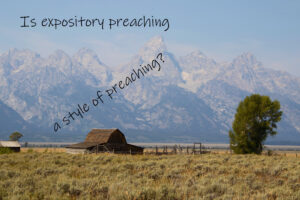 I frequently hear or read people who reject expository preaching because it’s not their style. Articles and even textbooks on homiletics sometimes refer to the different preaching styles as topical, textual, and expository. “If you want to preach expository sermons, that’s your style, but it’s not my style,” some pastors say. Others go further and argue that the style of expository preaching will not work in today’s world.
I frequently hear or read people who reject expository preaching because it’s not their style. Articles and even textbooks on homiletics sometimes refer to the different preaching styles as topical, textual, and expository. “If you want to preach expository sermons, that’s your style, but it’s not my style,” some pastors say. Others go further and argue that the style of expository preaching will not work in today’s world.
Is expository preaching a style of preaching?
ANCIENT RHETORIC AND THE QUESTION OF STYLE
Modern speakers still follow the methods described in Greco-Roman rhetoric even if they do not consciously think they do. The five canons of classical rhetoric are:
- Invention (Inventio): Invention refers to the content of the speech. The speaker creates (invents) the information and arguments that form the substance of his speech. This is the issue of expository preaching. Do we invent our content, or does our message come from the Bible?
- Arrangement (Dispositio): Arrangement refers to the structure of the speech – the introduction, body, and conclusion. Classical rhetoric identified six parts to a speech, but how a speaker arranged the information varied.
- Style (Elocutio): Style refers to words, sentence structure, analogies, and figures of speech. It is the way the preacher communicates. Does the preacher use jokes, colloquialisms, slang, flowery language, or more intellectual and academic language?
- Memory (Memoria): Memory refers to how much of the speech is committed to memory versus how much is read from written notes. Does the preacher use a manuscript, extensive notes, or free-flowing, extemporaneous speech?
- Delivery (Pronuntiato and Actio): Delivery refers to how the preacher uses gestures, voice, mannerisms, and movement to deliver the message. The Greeks called this canon hypocrisis, from which we get hypocrisy because delivery can be misleading.
THREE STYLES OF RHETORIC
Cicero taught that public speaking had three functions: 1) to teach, 2) to move, and 3) to please. These were considered the three styles of speaking. They are the plain, middle, and grand styles of speaking. The plain style was used for teaching an audience. The middle style was for moving an audience, and the grand style was for pleasing an audience. The Sophists emphasized the grand style of speaking. The grand style was highly emotional, colorful, provocative, and entertaining. The grand style, and to a lesser extent, the middle style, characterized the headline-grabbing, clickbait, outrage-driving speakers of their day.
When Paul wrote that he “did not come with superiority of speech or of wisdom, proclaiming to you (the Corinthians) the testimony of God” (1 Cor. 2:1), he was talking about style. When Paul wrote, “My message and my preaching were not in persuasive words of wisdom” (1 Cor. 2:4), he was talking about the Sophists and their grand style of speaking. Our style must not interfere with or replace the content of God’s Word. We are free to use different styles as long as the styles do not become more important than the biblical content.
The sermon arrangement and the preacher’s delivery style often replace or reduce the biblical content of the message. Popular preachers often use a grand or at least middle style of preaching because the style is more important than the substance. Some are colorful, flamboyant, and provocative. Others use passion and excitement. Still, others develop a conversational and chatty style. Traditional preachers often try to be eloquent and wordy. Others become zealous pulpit-pounders. These and other examples are styles of preaching in our world today. God’s warning is that our style must never replace biblical content. Our style should enhance, not hinder, the communication of God’s Word.
WHAT IS STYLE?
The dictionary defines style as:
- the manner or mode of expression in language as distinct from the ideas expressed;
- a specific or characteristic manner of expression, execution, construction, or design.[1]
Style has to do with the way in which a sermon is expressed. Does the preacher dress in Hawaiian shirts and shorts or a three-piece suit with a tie? Is it business casual or jeans and untucked shirts? Does the preacher use highly emotional and inflammatory language? Is the sermon provocative or instructive? Are the words academic and theological or slang and colloquial? In other words, are you a “dude” preacher or a “saints” preacher? Does the preacher walk around the platform in Converse sneakers and sit on a stool? Does he stand at a large pulpit in his shiny wingtips to preach? Is the sermon filled with personal stories and coffee shop talk, or does the preacher stick to impersonal analogies and rational arguments? These are all questions of style, yet all these styles can still be expository.
Expository preaching is about the content, not the style, the substance, not the form. Expository preaching is a mindset or philosophy that is committed to the simple idea that our job as preachers is to expose the text of Scripture. God speaks through His Word, not ours. The Bible is not a resource we use to sanctify our ideas but the source of the ideas that God wants to be preached. Expository preaching is text-driven. Our mission as preachers is to explain and apply what God says in the Bible while seeking to persuade listeners to change their lives in response.
In terms of classical rhetoric, we don’t get to invent (inventio) our message like other speakers in this world. We create a sermon. We do not invent a message. The message we preach is God’s message, even though the way we preach is our style.
Is expository preaching a style of preaching? No! Our delivery style does not determine whether a sermon is expository or not. The content does!
[1] Webster’s New World College Dictionary, 1332.


